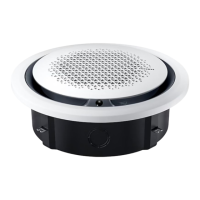20
Installation Procedure
English
Installation Procedure
CAUTION
• Be sure to use C1220T-1/2H (Semi-hard) pipe for
more than Ø19.05 mm. If you use C1220T-O (Soft)
pipe for Ø19.05 mm, the pipe may be broken, which
can result in an injury.
Make at least one round:
It will reduce noise and vibration
• The appearance of the unit may be different from the
diagram depending on the model.
CAUTION
• After connecting the pipes with knock-out treatment,
plug the space around the pipes.
• After connecting the pipes, proceed exactly as
directed in the guide to prevent interference with the
internal parts.
• Tighten the nuts to the specified torques. If
overtightened, the nuts could be broken so
refrigerant may leak.
• Protect or enclose refrigerant tubing to avoid
mechanical damage.
Step 6 Optional: Cutting and aring the
pipes
1 Make sure that you have the required tools available.
(pipe cutter, reamer, flaring tool, and pipe holder)
2 If you wish to shorten the pipes, cut it with a pipe
cutter, taking care to ensure that the cut edge remains
at a 90° angle with the side of the pipe. Refer to
the illustrations below for examples of edges cut
correctly and incorrectly.
Pipe cutter
Pipe
90°
Oblique
Rough
Burr
3 To prevent any gas from leaking out, remove all burrs
at the cut edge of the pipe, using a reamer.
4 Slide a flare nut on to the pipe and modify the flare.
D
A
D
45° ±2°
90° ±2°
Pipe
Flare
Flare
R 0.4 to 0.8 mm
L
Outer diameter (D) Depth (A) Flare dimension (L)
ø6.35 mm 1.3mm 8.7 to 9.1 mm
ø9.52 mm 1.8mm 12.8 to 13.2 mm
ø12.70 mm 2.0mm 16.2 to 16.6 mm
ø15.88 mm 2.2mm 19.3 to 19.7 mm
ø19.05 mm 2.2mm 23.6 to 24.0 mm

